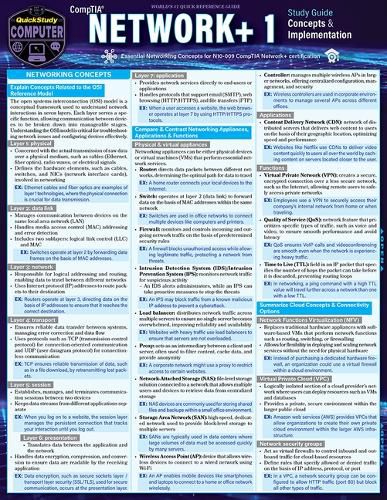Readings Newsletter
Become a Readings Member to make your shopping experience even easier.
Sign in or sign up for free!
You’re not far away from qualifying for FREE standard shipping within Australia
You’ve qualified for FREE standard shipping within Australia
The cart is loading…






First in a series of 2 reference guides that will make your life easier preparing for the Network+ certification exam with the most thorough yet compact and succinct study tool on the market. Six durably laminated pages, easy to store and review anywhere with concise answers and examples providing key content for unlocking the best score on the exam. Author George Antoniou, PhD, is a professor with 30 years of experience in information security, risk management, and quality assurance compliance as well as strategic planning and enterprise level security architecture, plus security operations and policy development in small-medium-large, national and multi-national complex information security technology infrastructures. His experience providing instruction ensures this guide is a handy and powerful tool. We guarantee you will find answers faster than any book or website for a price that makes it easy to add this to your Network+ test prep toolbox. Based on studies regarding retention with screens verses tactile in-hand study tools, along with the growing sales of our computer titles, print is not dead - give it a try. 6 page laminated guide includes explanations, differences, and examples within: NETWORKING CONCEPTS
Explain Concepts Related to the OSI Reference Model
Layer 1: physical, Layer 2: data link, Layer 3: network, Layer 4: transport, Layer 5: session, Layer 6: presentation, Layer 7: application
Compare & Contrast Networking Appliances, Applications & Functions
Physical & virtual appliances Applications, Functions
Summarize Cloud Concepts & Connectivity Options
Network Functions Virtualization (NFV) Virtual Private Cloud (VPC) Network security groups Network security lists Cloud gateways, Cloud connectivity options Deployment models, Service models, Key cloud concepts
Explain Common Networking Ports, Protocols, Services & Traffic Types
Common ports & protocols IP types, Traffic types
Compare & Contrast Transmission Media & Transceivers
Transmission media Transceivers Connector types
Compare & Contrast Network Topologies, Architectures & Types
Topologies Traffic flows
Given a Scenario, Use Appropriate IPv4 Network Addressing
Public vs. private addressing Subnetting IPv4 address classes
Summarize Evolving Use Cases for Modern Network Environments
SDN & SD-WAN, VXLAN, ZTA, SASE/SSE, IaC, IPv6 addressing
NETWORK IMPLEMENTATION
Explain Characteristics of Routing Technologies
Static routing, Dynamic routing Route selection, Address translation FHRP, VIP Subinterfaces
Given a Scenario, Configure Switching Technologies & Features
VLAN, Interface configuration, STP, MTU
Given a Scenario, Select & Configure Wireless Devices & Technologies
Channels, Frequency options SSID Network types Encryption Guest networks Authentication Antennas Autonomous vs. lightweight AP
Explain Important Factors of Physical Installations
Important installation implications Power considerations Environmental factors
$9.00 standard shipping within Australia
FREE standard shipping within Australia for orders over $100.00
Express & International shipping calculated at checkout
First in a series of 2 reference guides that will make your life easier preparing for the Network+ certification exam with the most thorough yet compact and succinct study tool on the market. Six durably laminated pages, easy to store and review anywhere with concise answers and examples providing key content for unlocking the best score on the exam. Author George Antoniou, PhD, is a professor with 30 years of experience in information security, risk management, and quality assurance compliance as well as strategic planning and enterprise level security architecture, plus security operations and policy development in small-medium-large, national and multi-national complex information security technology infrastructures. His experience providing instruction ensures this guide is a handy and powerful tool. We guarantee you will find answers faster than any book or website for a price that makes it easy to add this to your Network+ test prep toolbox. Based on studies regarding retention with screens verses tactile in-hand study tools, along with the growing sales of our computer titles, print is not dead - give it a try. 6 page laminated guide includes explanations, differences, and examples within: NETWORKING CONCEPTS
Explain Concepts Related to the OSI Reference Model
Layer 1: physical, Layer 2: data link, Layer 3: network, Layer 4: transport, Layer 5: session, Layer 6: presentation, Layer 7: application
Compare & Contrast Networking Appliances, Applications & Functions
Physical & virtual appliances Applications, Functions
Summarize Cloud Concepts & Connectivity Options
Network Functions Virtualization (NFV) Virtual Private Cloud (VPC) Network security groups Network security lists Cloud gateways, Cloud connectivity options Deployment models, Service models, Key cloud concepts
Explain Common Networking Ports, Protocols, Services & Traffic Types
Common ports & protocols IP types, Traffic types
Compare & Contrast Transmission Media & Transceivers
Transmission media Transceivers Connector types
Compare & Contrast Network Topologies, Architectures & Types
Topologies Traffic flows
Given a Scenario, Use Appropriate IPv4 Network Addressing
Public vs. private addressing Subnetting IPv4 address classes
Summarize Evolving Use Cases for Modern Network Environments
SDN & SD-WAN, VXLAN, ZTA, SASE/SSE, IaC, IPv6 addressing
NETWORK IMPLEMENTATION
Explain Characteristics of Routing Technologies
Static routing, Dynamic routing Route selection, Address translation FHRP, VIP Subinterfaces
Given a Scenario, Configure Switching Technologies & Features
VLAN, Interface configuration, STP, MTU
Given a Scenario, Select & Configure Wireless Devices & Technologies
Channels, Frequency options SSID Network types Encryption Guest networks Authentication Antennas Autonomous vs. lightweight AP
Explain Important Factors of Physical Installations
Important installation implications Power considerations Environmental factors